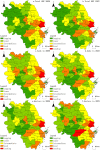Spatial-temporal evolution of the allometric relationship between urban economic and health resources in the Yangtze River Delta urban agglomeration
- PMID: 39854516
- PMCID: PMC11759377
- DOI: 10.1371/journal.pone.0314315
Spatial-temporal evolution of the allometric relationship between urban economic and health resources in the Yangtze River Delta urban agglomeration
Erratum in
-
Correction: Spatial-temporal evolution of the allometric relationship between urban economic and health resources in the Yangtze River Delta urban agglomeration.PLoS One. 2025 Apr 7;20(4):e0322414. doi: 10.1371/journal.pone.0322414. eCollection 2025. PLoS One. 2025. PMID: 40193362 Free PMC article.
Abstract
The evolution of the spatiotemporal relationship between urban economic growth and health resources within the Yangtze River Delta urban agglomeration provides an important context for understanding the regional development dynamics in China. Previous studies focused on equity in health-resource allocation and service efficiency, often overlooking the allometric growth relationships between health resources and economic variables. This study employs an allometric growth model to elucidate the changing interactions between the number of medical beds, doctors, and urban economic indicators in the Yangtze River Delta region from 2009 to 2022. Employing Zipf's law and allometric growth modeling, this study analyzed growth trends and revealed significant differences in resource allocation and size changes over time. The main findings suggest that, although resource centralization is a general trend, differences persist, especially in less economically developed regions. This study innovatively introduces an allometric growth model that offers a new perspective on understanding the mechanisms of regional health-resource growth and underscores the significant influence of economic factors on health-resource allocation. This study significantly contributes to the sustainability of urban health systems and provides theoretical support for policy formulations aimed at optimizing the allocation of health resources and strengthening regional economic strategies in the Yangtze River Delta region.
Copyright: © 2025 Jing et al. This is an open access article distributed under the terms of the Creative Commons Attribution License, which permits unrestricted use, distribution, and reproduction in any medium, provided the original author and source are credited.
Conflict of interest statement
The authors have declared that no competing interests exist.
Figures






References
-
- Hongwei Hu, Jingru Wang, Shuiying Yuan, Xiaojing Du. Health resources and the nation’s health: does increased investment in health resources worsen the nation’s health. Social Security Studies. 2016;01:61–71. (in Chinese)
-
- Shuangs Chen, M L, Jun Hu, Lina Qian, Chenling Shi, Peijia Wang. Research on equity and efficiency of primary health resource allocation in China, 2017–2021. Chinese Rural Health Service Administration. 2023;43(10):701–707. (in Chinese)
-
- Lufa Z. A study on the balance and optimization of regional medical resources allocation in Chinese metropolitan areas. Nanjing Journal of Social Sciences. 2019;(02):65–72. (in Chinese)
MeSH terms
LinkOut - more resources
Full Text Sources

